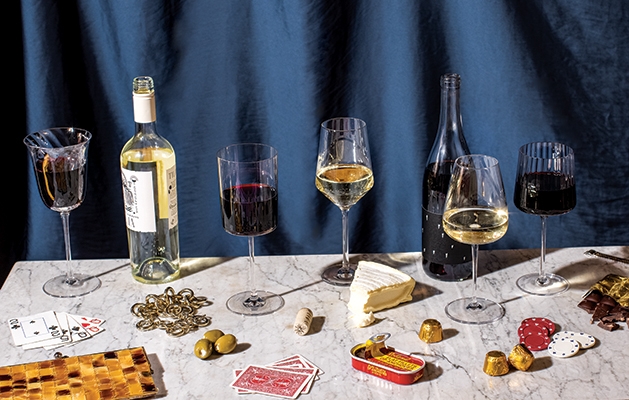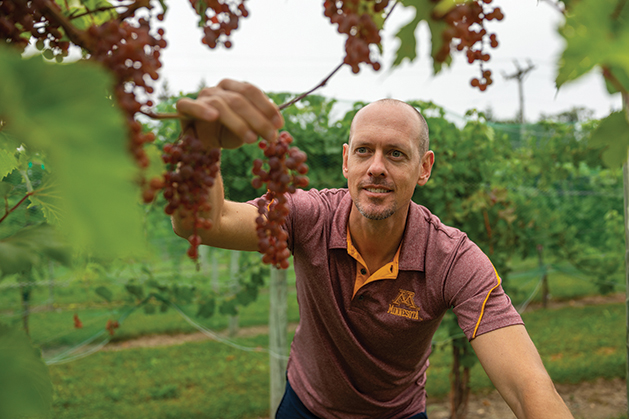
Wine can be appreciated all year, but it’s especially apropos during the holiday season. Dinner parties, restaurant gatherings and holiday gift giving tend to make wine top of mind for many revelers. We connected with local experts for information to help would-be wine drinkers gain confidence with buying, ordering and gifting wine during the holidays, or for that matter, any time of year.
Sarina Garibović is a certified sommelier and owner of Ženska Glava, a woman-owned and operated wine and spirits events business. She also founded Twin Cities Somms, a nonprofit with fellow sommeliers.
Let’s start with what to look for in wine. “As a somm, what we’re thinking about is what do you usually like to drink? What flavor profiles do you already appreciate? If you love a California pinot noir, you probably like fruity wine with some acidity,” Garibović says. “Also, price is a factor for everyone, so we might ask which producers you enjoy in order to see what you’re used to paying; because you might not love a fantastic wine if you feel like you’ve overpaid.” For adventurous sippers, Garibović leans toward wines from underrepresented regions like Slovenia because, “It can be good and also be a better value,” she says.
Garibović stresses the importance of asking questions. “Don’t be afraid or embarrassed to ask questions because a little bit of knowledge can go a long way, for example knowing things like more fruit character typically comes from a warmer climate where there is riper fruit and more sugar and higher alcohol,” she says.
We dove deeper into our wine glass and asked Garibović’s opinion about some common wine varieties.
REDS:
Cabernet: In a restaurant setting, if a guest tells me they frequently enjoy cabernet sauvignon from the Napa Valley, it can give me a lot of information about the character of the fruit they may expect, whether they expect the wine to undergo barrel aging as well as the price they are accustomed to spending on a bottle. The land in Napa Valley is quite expensive, and new oak barrels are used to produce many cabernet sauvignons in the area, all leading to a higher cost for the finished wine.
Merlot: Merlot used to be quite popular but has since fallen out of favor with many drinkers, arguably due to the popular movie Sideways, which created a preference for pinot noir. This makes merlot, a delicious wine worthy of frequent enjoyment, on par with a passion project for many producers. Much like cabernet sauvignon, merlot is a wine with grippier tannins, lots of ripe fruit character and pairs well with weightier dishes like steak.
Pinot Noir: Pinot noir is a hugely popular grape variety that can express itself in wildly variable ways due to factors, such as climate, soil type, aspect and aging methods. If you love pinot noir from Burgundy or Oregon but find the offerings restrictive due to budget, try Gamay from the same places, which can offer similar qualities with a typically more affordable price tag.
Malbec: Malbec, originating in France where it is known as cot, has really exploded in popularity and low-cost examples are practically ubiquitous. The issue with malbec occurs when the cheap examples available in grocery stores cannot be found on wine lists, and are instead replaced by higher quality examples at surprisingly high prices. This is because though malbec originated in France, it is now produced primarily in Mendoza, Argentina, where it can vary greatly in quality depending on where it is grown and the methods used to produce it. Stick to affordable examples when buying retail for everyday wines but talk with your server in a restaurant and they can help you find a great example or another wine that matches your preferences.
Zinfandel: Zinfandel can be misunderstood because of the way the grape bunches ripen on the vine. Unlike other red grapes, which ripen relatively at the same speed, becoming darker and concentrating sugars over time, zinfandel can have a bunch of grapes with green grapes, ripe grapes and raisins all at the same time. In the finished wine, this can mean a range of fruit characters and perception of body and texture. More and more, producers are aiming for more balanced zinfandel rather than pushing the limits of harvest time to get the most ripe fruit, which has, in the past, contributed to the perception of zinfandel is a big, jammy wine. The rich and ripe style can be great for pairing with weightier and more intense dishes, just talk to your wine pro to find out which example might be right for you and the occasion.
WHITES:
Sauvignon Blanc: Garibović says, “Sauvignon Blanc is so popular, and in so many people's comfort zone, that at times it can be hard to guide guests to any other wine on the menu.” It’s refreshing and crisp but also has a uniquely green character, like bell pepper or a gooseberry quality. It pairs well with vegetable dishes or foods with an herb component. Most folks like the crispness and fruity quality of many New Zealand Sauvignon Blancs but there are other options like Sancerre from the Loire Valley in France or Styria in southern Austria that are worth trying.
Riesling: Known as the darling of somms; “We all adore it,” says Garibović. Due to the popularity of liebfraumilch in the '80s (Blue Nun) there is a common idea that all Riesling is sweet, creating a well-known and oft-examined difficulty of selling the wine in many settings. If you like a high acid, high tone, crisp, electric white wine, you cannot find a better option with lime, lemon, apricot flavors. Though even Riesling with sweetness shouldn't be discounted, due to its high acidity, the sugar is easily balanced and sometimes practically imperceptible. Riesling is also hugely versatile in food pairing; turn to a dry example for salads with a vinaigrette, weightier and more concentrated bottles for spicy dishes, and the classically sweet styles for fruit tarts and many other desserts.
Pinot Gris: Same as pinot grigio, both are wonderful, crisp and neutral with a fresh style. Gris is from France and expresses itself differently, a little richer and with a golden hue. A bottle of Gris is a wine for a table of four because it pairs with most everything.
Chardonnay: Known as a love it or leave it variety, climate and winemaking have a great impact on Chardonnay as a finished wine. A fairly neutral grape, tending towards a high toned, chalky, minerally wine from cool climates like Chablis, and riper apple, and even tropical fruits when grown in a warm place like Napa, Chardonnay can be many things. Chardonnay can act as a microscope to the place, the terroir in which its grown, but it can also be a wine of process when winemaking like lees stirring (to create creamininess), malo lactic conversion (the source of that buttered popcorn aroma) and oak usage (vanilla aromas and flavor) are employed. So, it’s important to ask, “Where does it come from and how is it made”? Cost can be a window into style as well, since extending time before bottling and the use of new oak barrels create a lot of expense for winemakers.

Is Rosé still a thing?
Garibović says, “Yes. It’s a thing, and somms want to make rosé popular all year-round because the idea that you can only drink it in the summer and only crisp varieties are from southern France isn’t really true. There are beautiful examples from Germany, Austria and California. It also has the ability to age, so a rosé that is not from 2020 is totally fine. In fact, seek out a rosé with a couple of years of age and see how it goes.”
Why is white wine served chilled?
It is frequently served too chilled, and red wine is not chilled enough. Most restaurants keep wine in a beer cooler at 36 degrees, which is too cold. White wines taste better when they’ve had some time to warm up a bit. Red wines are best at 55–65 degrees. When red wine is too warm, the alcohol overrides other flavors.
What makes a good cooking wine?
If you cook so much that you need specific cooking wine, go for something in the middle … But most people also don’t want a $20 cooking wine. If you care about the ingredients you put in your food, you should care about the sourcing of your wine for cooking.
What’s the best bottle to bring to a dinner party or give as a gift?
To share, bring a bottle that pairs well with food. Beaujolais goes well with lots of dishes, or select a red from Jura in France, where you can find textured red wines with balance and impress your friends with wine from a lesser known place. For a gift, if you want a high impact, give Champagne, though sparkling wines can be just as good and at a lower price point. Garibović also recommends gifting magnums (larger bottles that hold as much wine as two standard bottles) because they have a celebratory impact and can age for longer because there is less oxygen exchange before opening. Magnums are also great for the dinner table because they’re indulgent. You can find a good one for around $60.

Gopher State Grapes
In cold-climate Minnesota, which boasts just 80 wineries, fruity frontenac varietals and sweet la crescent take the lead.
The state produces cold-hardy and disease-resistant wine grapes. At the University of Minnesota’s (UMN) Minnesota Agricultural Experiment Station, one of the top grape research programs in the country, more than 12,000 experimental vines are cultivated.
Matthew Clark, assistant professor of grape breeding and enology and the Minnesota Landscape Arboretum’s director of research, says, “At the University of Minnesota, our grape breeding project has focused on developing new varieties of grapes … [It’s] focused on bringing in genetics through breeding methods of high-quality wine grapes that people are familiar with and bringing in the cold to learn what varieties can grow here.”
Although cold climates were once deemed “too cold” for fine wines, regions are now capable of producing such wines if the grape varieties possess the properties needed to sustain the climate.

Clark says Minnesota’s short growing season and severe winters contribute to how long grapes are on the vine, which plays a major role in flavor and aroma development. “The grapes in Minnesota do quite well with our short season because they’ve been selected and adapted for those environments,” he says.
At the UMN’s experiment station, cultivating a new wine variety takes an average of 20 years. The enologists use traditional breeding methods to crossbreed the grapes to bring out the traits they are interested in. “This year, we are planning to make 50 crosses, [and] from that we will target 5,000 seeds to grow next year,” Clark says. Genetic testing for specific traits and disease resistance follows; and after the vineyard produces fruit, three to five years later, the enologists taste it and determine if it is worth evaluating for a second time.
“In many cases, the answer is no. Things that perform well [are] one-in-a-thousand vines,” Clark says. “In our case, we grow 10,000 vines at one time, so we go through and pick out the vines performing well. Over the year, we make 75–100 wines and taste those to help us make decisions about a new variety.”
To produce a new variety, the station relies on university collaborators to test the vines. Once a new variety is released, the station works with growers to produce the vines, nurseries to propagate the vines and licensees to sell the vines.
“We certainly grow different varieties,” Clark says. La crescent is one variety, which has a high aromatic and is compared to moscato. “We often hear people say that wines in the Midwest are sweet … One reason we might see more sweet wines in the Midwest is because the grapes have a higher acidity,” he says.

Residual sugar, found in wines with a good balance of sugar and acid, can offset the tartness in wine grapes and, in turn, create sweeter wines. Although many of the wines produced by the UMN have been on the sweeter side, Clark says the program is focusing on developing new wine grapes with lower acidity, with the goal of producing more dry wines.
The most recent variety, 2017’s Itasca, features lower acidity and high sugar levels. The variety outperformed everything in its class and survived the 2013–14 polar vortex; “It received an A+ grade,” Clark says. The white wine has been a bestseller among the UMN’s varieties.
Over 100 selections are being tested for cold hardiness, disease resistance and viticultural traits. However, it may just be another 20 years before we see another variety released.
Correction: This is an updated version of the Wine of the Times Tastemakers story originally published in the November 2021 issue of Lake Minnetonka Magazine.









